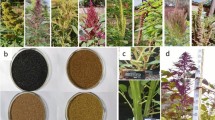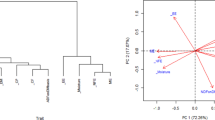Abstract
Significant genetic diversity was observed in 218 out of a total of 1309 accessions of amaranth (Amaranthus hypochondriacus L.) and its seven wild relatives, A. spinosus L., A. dubius Mart. ex Thell., A. hybridus L., A. tricolor L., A. cruentus L., A. caudatus L., A. retroflexus L. for 24 nutritional parameters including total oil content, fatty acid profile, total protein content and amino acid profile. Diversity for total oil content (6.42–12.53%), linoleic acid (25.68–54.34%), oleic acid (21.97–42.01%) of the total fatty acids, total protein content (7.84–18.01%), among important essential amino acids; lysine content (0.66–11.12 g/16 g N), methionine (0.35–4.80 g/16 g N) and half cystine and (0.12–8.32 g/16 g N) was reported. The un-weighted pair-group method using arithmetic average cluster analysis based on pair wise Euclidean genetic distance grouped the accessions into seven major clusters. Histidine, half cystine, tyrosine, essential amino acids, total oil content, linoleic acid and oleic acid content were the major parameters contributing significantly to genetic diversity. Present findings indicate that significant diversity exists for nutritional parameters in amaranth germplasm. The promising accessions with higher multiple nutritive traits; protein content (>16%), oil content (>11%), lysine content (>7.5 g/16 g N) and EAA higher than the FAO reported values, were identified. This is the first report on detailed nutritional analysis of diversity collected worldwide. These could be used as potential breeding material for nutritional enhancement through genetic improvement. This will help in overcoming the “triple burden” of malnourishment, hidden hunger, and obesity.



Similar content being viewed by others
References
Alvarez-Jubete L, Arendt EK, Gallagher E (2010) Nutritive value of pseudocereals and their increasing use as functional gluten free ingredients. Trends Food Sci Technol 21:106–113
AOAC (1995) Official methods of analysis, 15th edn. Association of Official Analytical Chemists, Washington
Barba de la Rosa AP, Formsgaard IS, Laursen B, Mortensen AG, Olvera-Marínez L, Silva-Sánchez C (2009) Amaranth (Amaranthus hypochondriacus L.) as an alternative crop for sustainable food production: phenolic acids and fl avonoids with potential impact on its nutraceutical quality. J Cereal Sci 49:117–121
Bressani R (1989) The proteins of grain amaranth. Food Rev Int 5:13–38
Bressani R, Gonzalez JM, Zũniga J, Breuner M, Elias LG (1987) Yield and selected chemical composition and nutritional value of 14 selections of amaranth grain representing four species. J Sci Food Agric 38:347–356
Budin JT, Breene WM, Putnam DH (1996) Some compositional properties of seeds and oils of eight amaranthus species. Am Oil Chem Soc 73:475–481
Cohen SA, Michaud DP (1993) Synthesis of a fluorescent derivatizing reagent, 6-aminoquinolyl-N-hydroxysuccinimidyl carbamate, and its application for the analysis of hydrolysate amino acids via high performance liquid chromatography. Anal Biochem 211:279–287
FAO/WHO (1990) Protein quality evaluation. Report of a joint FAO/WHO expert consultation. Food and Agriculture Organization/World Health Organization of United Nations, Rome
Gamel TH, Mesallam AS, Damir AA, Shekib LA, Linssen JP (2007) Characterization of amaranth seed oils. J Food Lipids 14:323–334
Gorinstein S, Pawelzik E, Delgado-Licon E, Haruenkit R, Weisz M, Trakhtenberg S (2002) Characterisation of pseudocereal and cereal proteins by protein and amino acid analysis. J Sci Food Agric 82:886–891
Grubben GJH (2004) Amaranthus spinosus L. In: Grubben GJH, Denton OA (eds) Plant resources of tropical Africa 2. Vegetables. PROTA Foundation, Wageningen, pp 80–83
Hanbury CD, Sarker A, Siddique KHM, Perry MW (1995) Evaluation of Lathyrus germplasm in a mediterranean type environment in south-Western Australia. Occasional paper no. 8. Co-operative Research Centre for Legumes in Mediterranean Agriculture
Joshi V, Gautam PL, Mal B, Sharma GD, Kochhar S (2002) Conservation and use of underutilized crops: an Indian perspective. In: Engels JMM, Rao VR, Brown AHD, Jackson MT (eds) Managing plant genetic diversity. IPGRI, Rome
Kalac P, Moudry J (2000) Chemical composition and nutritional value of amaranth grains (in Czech). Czech J Food Sci 18:201–206
Kauffman CS (1992) Realizing the potential of grain amaranth. Food Rev Int 8:5–21
Koziol MJ (1992) Chemical composition and nutritional evaluation of quinoa (Chenopodium quinoa Willd.). J Food Compos Anal 5(1):35–68
Martirosyan DM (2001) Amaranth as a nutritional supplement for the modern diet. Amaran Leg USA 14:2–4
Martirosyan DM, Sargsyan AV, Parsadanyan RA (2005) Functional food for the prevention of hypertension. In: Martirosyan DM (ed) Book functional foods for cardiovascular diseases. D & A Inc., Dallas, pp 200–206
Martirosyan DM, Miroshnichenko LA, Kulakova SN, Pogojeva AV, Zoloedov VI (2007) Amaranth oil application for coronary heart disease and hypertension. Lipids Health Dis 6:1–12
Mensik RP, Katan MB (1989) Effect of a diet enriched with monounsaturated or polyunsaturated fatty acid on the levels of low-density and high-density lipoprotein cholesterol in healthy women and men. N Engl J Med 32:436–441
Mlakar SG, Turinek M, Jakop M, Bavec M, Bavec F (2009) Nutrition value and use of grain amaranth: potential future application in bread making. Agricultura 6:43–53
Pedersen B, Hallgren L, Hansen I, Eggum BO (1987) The nutritive value of amaranth grain (Amaranthus caudatus) 2. As a supplement to cereals. Plant Foods Hum Nutr 36:325–334
Pisarikova B, Zraly Z, Kracmar S, Trckova M, Herzig I (2005) Nutritional value of amaranth (genus Amaranthus L.), grain in diets for broiler chickens. Czech J Anim Sci 50:568–573
Saunders RM, Becker R (1984) Amaranthus: a potential food and feed resource. In: Pomeranz Y (ed) Advances in cereal science and technology. American Association of cereal Chemists, St. Paul, pp 375–396
Shukla S, Singh SP (2000) Studies on genetic parameters in vegetable amaranth. J Genet Breed 54:133–135
Stefansson BR, Storgaard AK (1969) Correlation involving oil and fatty acids in rapeseed. Can J Plant Sci 49:573–580
Suneja P, Yadav S, Mandal S, Negi KS, Muneem KC, Mishra SK (2009) Oil and protein quality of black seeded soybean germplasm. Ind J Plant Genet Resour 23(1):34–39
Svirskis A (2003) Investigation of amaranth cultivation and utilization in lithuania. Agron Res 1(2):253–264
Swaminathan MS (1999) Enlarging the basis of food security: role of unutilized species. In: Proceedings of the international consultation organized by the genetic resources policy committee (GRPC) of CGIAR, M.S. Swaminathan Research Foundation, Chennai
Teutonico RA, Knorr D (1985) Amaranth: composition, properties, and applications of a rediscovered food crop. Food Technol 39:49–60
Thompson T (2001) Case problem: question regarding the acceptability of buckwheat, amaranth, quinoa, and outs from a patient with celiac disease. J Am Diet Assoc 101:586–587
Wassef WN (1985) Lipids. In: Fennema E (ed) Food chemistry, 2nd edn. Marcel Dekker Inc, New York and Basel, pp 140–244
Yadav S, Suneja P, Hussain Z, Abraham Z, Mishra SK (2011) Genetic variability and divergence studies in seed and oil parameters of mahua (Madhuca longifolia Koenig) J.F. Macribide accessions. Biomass Bioenergy 35:1773–1778
Acknowledgements
The authors thank the Department of Science and Technology and Indian Council of Agricultural Research, Govt. of India for the financial assistance to carry out this research. The authors also thank Ms. Y. Gunwal for helping in data analysis.
Author information
Authors and Affiliations
Corresponding author
Rights and permissions
About this article
Cite this article
Shukla, A., Srivastava, N., Suneja, P. et al. Untapped amaranth (Amaranthus spp.) genetic diversity with potential for nutritional enhancement. Genet Resour Crop Evol 65, 243–253 (2018). https://doi.org/10.1007/s10722-017-0526-0
Received:
Accepted:
Published:
Issue Date:
DOI: https://doi.org/10.1007/s10722-017-0526-0




